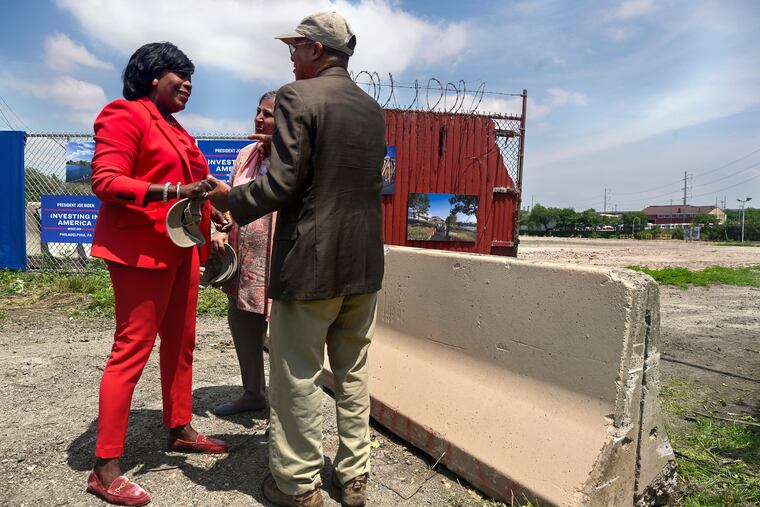EPA targets $2M cleanup of Schuylkill riverfront property near Bartram’s Garden
The parcel is part of plans for what’s dubbed the Lower Schuylkill Biotech Campus, which would be fronted by the Bartram’s Mile trail.

The U.S. Environmental Protection Agency on Monday announced that it will spend $2 million to clean up a former oil terminal that local officials call the “last piece of the puzzle” to a large redevelopment project along the Schuylkill waterfront near Bartram’s Garden.
The parcel is part of plans for what’s dubbed the Lower Schuylkill Biotech Campus, which would be fronted by the Bartram’s Mile trail, a 1.55-mile paved path that stretches through the Southwest Philadelphia garden. The project, led by the nonprofit Philadelphia Industrial Development Corp. (PIDC), aims to bring jobs and recreation to a once heavily industrialized and contaminated section of the west bank of the river.
Officials said the grant, funded by the Bipartisan Infrastructure Law, will by used by PIDC to clean up the 49th Street Terminal at 1700 S. 49th St. The site, just less than an acre, was an oil terminal from 1942 to 2006. Currently vacant, it is contaminated by petroleum and semi-volatile organic compounds.
When it closed, the terminal became yet another polluted, unusable parcel in Kingsessing.
But the land is part of a string of parcels reclaimed along Bartram’s Mile for the planned 40-acre campus, which would be divided into a 20-acre section north of Bartram’s Garden and a 20-acre section south of it. Officials hope to lure companies that work in cell and gene therapy production. However, plans are still being conceptualized.
Jodie Harris, president of PDIC, which was founded by the City of Philadelphia and the Chamber of Commerce for Greater Philadelphia, said the pollution and cleanup of the 49th Street Terminal is still being assessed.
“This project provides a long overdue investment in a predominantly African American community that has not received adequate investment or resources,” Harris said.
Angie Fredrickson, vice president of real estate services at PIDC, said the 49th Street Terminal site is “the last piece of the puzzle” to move forward with the campus.
$300 million nationwide
The grant for the 49th Street Terminal was part of $300 million announced by the Biden administration to address polluted brownfields, which are often in communities where 20% or more people live at or below the federal poverty line and 30% or more identifies as a minority.
EPA Administrator Michael S. Regan made the national announcement for the grants at the 49th Street Terminal property. Grants will go to clean up 180 sites across the U.S., including others in Pennsylvania and New Jersey.
“President Biden sees contaminated sites and blighted areas as an opportunity to invest in healthier, revitalized communities,” Regan said. “That is why he secured historic funding under the Bipartisan Infrastructure Law, supercharging EPA’s Brownfields program to clean up contaminated properties in overburdened communities and bring them back into productive use.”
Philadelphia Mayor Cherelle L. Parker thanked Biden, saying that: “Thanks to these historic resources, we’re moving further and faster than ever before to clean up contaminated sites to spur economic redevelopment.”
U.S. Rep. Mary Gay Scanlon, whose 5th District encompasses the waterfront, said the cleanup “is going to open up previously inaccessible areas along the Schuylkill River, and that’s going to create access to safe and affordable economic and recreational opportunities.”
Other local cleanups receiving funding:
$1 million to Camden Lutheran Housing Inc. to clean up the site of the former West Jersey Paper Manufacturing Site in Camden, which is vacant and contaminated with heavy metals, arsenic, polycyclic aromatic hydrocarbons, and PCBs.
$500,000 to the Camden Redevelopment Agency to perform environmental site assessments in East Camden, including a former chemical manufacturing site.